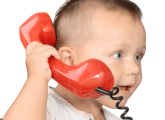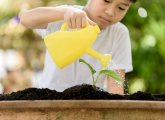If you thought maths vocabulary was just about numbers, think again, says Madeleine Fox…
One more. Too many. How much?
These are words that most of us utter on a daily basis without a thought. But in the world of EYFS, these are terms that can cement mathematical ideas in young minds.
If you’re looking for ideas of how to imbed maths vocabulary and understanding into your continuous provision, the natural world (especially in autumn) is filled with treasures to help you in your quest. Here are some ideas.
Start with an outdoor hunt. Take your class or group to a forest, wood, allotment, garden or even just your outdoor classroom area.
Below I’ve emboldened some of the mathematical words that will occur naturally throughout these activities – but there will be many more!
Firstly, look for trees. These are a great starting point as trees usually yield a host of treasures – leaves, twigs, seeds, acorns, apples, pine cones, etc.
Make collections of natural objects on your walk and encourage children to talk about what they find and where. This is where our first mathematically linked language will come into play as we walk through nature and explore: Under the tree, on the bank, over the gate.
Invite children to put collections in the basket encouraging the use of positional language. ‘Where did you find them? Where have you put them?’
As you hunt, ask children to find ‘one more leaf’, encouraging counting as you hunt. ‘How many?’ ‘How much?’
Talk about length and measures. Ask children to find a leaf the same size or a twig that is longer or shorter. You could set up a hunt within the hunt – hide objects in different places to invite specific maths vocabulary as you ask, ‘‘Where was it?’.
Put the collections in a basket to take back to the classroom to sort, count and compare. If you’re not able to take your class out, prepare collections to take in and hide in a basket for sorting. This might be produce or your own natural collections from walks.
Introduce the concept of sorting during whole class circle time. Have a big blanket or sorting mats ready to lay your previously collected small treasures out on.
You could use different shape sorting mats made from card – square, circle, rectangle – for extra practice of 2D shape names.
You can also supply some hoops that children can use as overlapping sets for Venn diagrams. Use string with paper and pens to jot down headings for marking out Carroll diagrams.
Try covering the basket with a cloth to add to the mystery and anticipation. Invite the class to join the circle by shaking some jingle bells or with a simple circle time song, such as this one set to the tune of Frere Jacques:
Make a circle, make a circle
Everyone, everyone
Come and make a circle, come and make a circle
Everyone, everyone
I use a squirrel puppet called Sorting Sally for my sorting activities. You could sing a rhyme to get everyone involved once in the circle. This one is set to the tune of Trot my Pony:
Sorting Sally, one two three
What’s in the basket? Look and see
Sorting Sally, four five six
Under the blanket. What’s your mix?
If these treasures are small you can tip them out onto the blanket.
Sorting Sally can invite a child to choose an item. What have they chosen? Place the item on a sorting mat. Can they name it? If so, invite a description. For example, a leaf could be curved, spiky or green.
Ask the next child to choose an object. Ask them, ‘Is this the same or different?’. Notice the mathematical concept of differences that we are introducing through our language here.
Discuss together how you might need to sort it onto a different mat. Continue around the circle until you’ve sorted a selection of the treasures. You can now sort each mat by size: big, bigger, biggest, long, longer, longest.
Ask the children if the items can be sorted by shape:
Some objects may have two of these attributes, so you might use your Venn diagram hoops here.
Can the children sort the objects in a different way? For example, a set of leaves and a set of not leaves. This will give an early introduction to the concept of a Carroll diagram.
Which set has the most? Which set has the fewest? Can you tell by looking? You can have fun estimating first, then counting the objects. Model counting by touching and moving the object so you don’t count it twice. This is a lovely way of making counting multisensory and purposeful.
Have number cards ready to put onto a set that you’ve counted. Invite a child to select the correct numeral card. Can the children identify the set with the most or the fewest? Have a large number line for reference to check the position of the numbers.
You can ask the same kinds of questions of larger objects. Perhaps you can sort by weight – heavy, heavier, heaviest – as well as the previous concepts. Can you sort them into a set of fruit or a set of vegetables?
Try to match the estimating, counting and comparing amounts to large numerals.
Introduce the idea of making patterns. What repeating patterns can you make? Use real objects to make lines of patterns along the floor – this is a rudimentary concept of early algebra.
Ask children to talk about the pattern you have made. Urge them to continue the pattern or make their own, using two or three objects in a sequence. For example, leaf, acorn, conker, leaf, acorn, conker.
Set up smaller baskets and bowls of objects around the classroom for children to sort and count alone or in groups. Change the objects regularly to add variety.
Display flash cards in these sorting areas of words you’ve introduced, to remind everyone to practise using them when talking. Add new words as the class explores new maths vocabulary.
Using paint is a great way to practise maths and encourage talking. Use paint and big paper to make sets of printed objects – this adds another sensory dimension to talking maths.
Slice vegetables in half and examine the shape and texture inside the vegetables. This introduces more mathematical language: round, oval, flat.
Children can paint or print sets of lots, a set of one, an empty set. They can make sets of numbers within 10 and paint the numeral for extra practice.
Make printed patterns with leaves or slices of potato, apple or carrot prints. How long can you make a printed pattern? Make collage patterns with leaves and seeds by sticking the actual objects onto strips of paper or cardboard. Make sets of seeds or leaves to match to a numeral. Fill in large numeral shapes with seeds and natural objects.
Make pictures and patterns with the natural objects on the floor both inside and outside. Draw different images and let the children explore the shapes of the objects and how they fit together.
We shouldn’t underestimate the wealth of mathematical language you can stimulate and use naturally within these sorting activities. Role modelling with the whole class first in a circle time session is a good way to demonstrate with everyone together. You can then follow this up through activities in continuous provision.
Talking maths as part of daily classroom life makes maths real. It also stimulates so many other areas of speech and language through the descriptive maths vocabulary and social exchange of language. See how many more activities you can think of and get talking maths!
Madeleine Fox is an educational writer and former SEN teacher.

Oral language – Laying the foundations in early years
Editors picks

Schematic play
Editors picks
